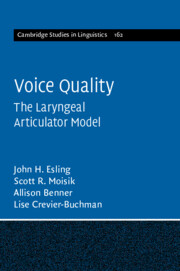Book contents
- Voice Quality
- Series page
- Cambridge Studies in Linguistics
- Voice Quality
- Copyright page
- Contents
- Figures
- Tables
- Preface
- Acknowledgements
- Abbreviations
- 1 Voice and Voice Quality
- 2 Laryngeal Voice Quality Classification
- 3 Instrumental Case Studies and Computational Simulations of Voice Quality
- 4 Linguistic, Paralinguistic, and Extralinguistic Illustrations of Voice Quality
- 5 Phonological Implications of Voice Quality Theory
- 6 Infant Acquisition of Speech and Voice Quality
- 7 Clinical Illustrations of Voice Quality
- 8 Laryngeal Articulation and Voice Quality in Sound Change, Language Ontogeny and Phylogeny
- References
- Author/Artist Index
- Subject Index
6 - Infant Acquisition of Speech and Voice Quality
Published online by Cambridge University Press: 21 June 2019
- Voice Quality
- Series page
- Cambridge Studies in Linguistics
- Voice Quality
- Copyright page
- Contents
- Figures
- Tables
- Preface
- Acknowledgements
- Abbreviations
- 1 Voice and Voice Quality
- 2 Laryngeal Voice Quality Classification
- 3 Instrumental Case Studies and Computational Simulations of Voice Quality
- 4 Linguistic, Paralinguistic, and Extralinguistic Illustrations of Voice Quality
- 5 Phonological Implications of Voice Quality Theory
- 6 Infant Acquisition of Speech and Voice Quality
- 7 Clinical Illustrations of Voice Quality
- 8 Laryngeal Articulation and Voice Quality in Sound Change, Language Ontogeny and Phylogeny
- References
- Author/Artist Index
- Subject Index
Summary
Chapter 6 investigates the earliest steps of how infants acquire the phonetic capacity to speak. It is relevant to voice quality that infants begin life with laryngeally constricted qualities, based on which they develop elaborated oral articulations with laryngeal quality as background. Ontogenetically, speech begins with the laryngeal articulator. New drawings illustrate the infant vocal tract (vs. the adult vocal tract). The companion website contains over 100 audio files of phonetic stages during the first year of life, comparing articulatory development in English with Tibeto-Burman Bái. The LAM provides the basis for understanding the distribution of non-syllabic and syllabic utterances, focusing on intermediate ‘mixed’ utterances. During the first several months of life, infants parse phonetic possibilities, refining the identity of potential individual sounds against the emerging backgrounds of long-term laryngeal qualities. Laryngeal voice quality reflects a complex interaction between the developing physiology of the infant vocal tract and the innate disposition to engage in vocal exploration, playing a crucial role in speech development.
Keywords
- Type
- Chapter
- Information
- Voice QualityThe Laryngeal Articulator Model, pp. 185 - 204Publisher: Cambridge University PressPrint publication year: 2019



